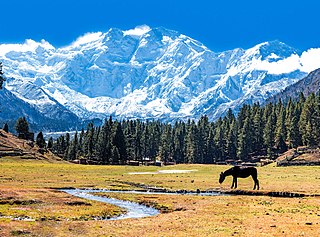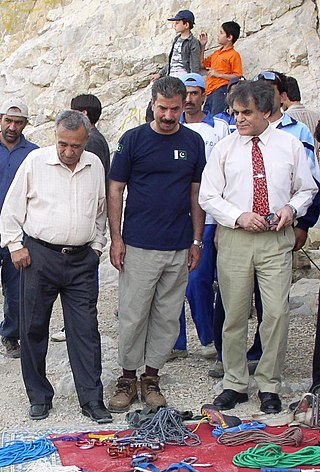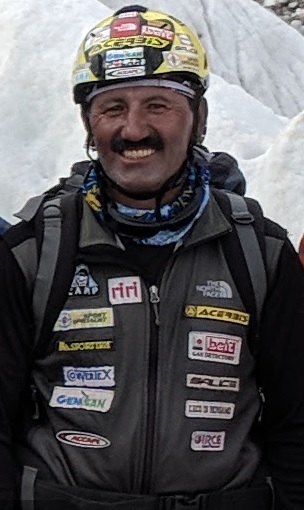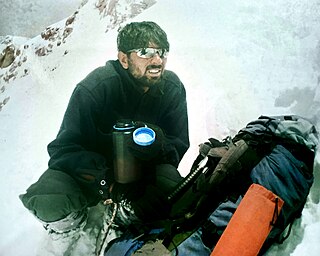
K2, at 8,611 metres (28,251 ft) above sea level, is the second-highest mountain on Earth, after Mount Everest at 8,849 metres (29,032 ft). It lies in the Karakoram range, partially in the Gilgit-Baltistan region of Pakistan-administered Kashmir and partially in the China-administered Trans-Karakoram Tract in the Taxkorgan Tajik Autonomous County of Xinjiang.

Reinhold Andreas Messner is an Italian climber, explorer, and author from South Tyrol. He made the first solo ascent of Mount Everest and, along with Peter Habeler, the first ascent of Everest without supplemental oxygen. He was the first person to climb all 14 eight-thousanders, doing so without supplementary oxygen. Messner was the first to cross Antarctica and Greenland with neither snowmobiles nor dog sleds and also crossed the Gobi Desert alone. He is widely considered to be the greatest mountaineer of all time.

Nanga Parbat, known locally as Diamer, is the ninth-highest mountain on Earth and its summit is at 8,126 m (26,660 ft) above sea level. Lying immediately southeast of the northernmost bend of the Indus River in the Gilgit-Baltistan region of Pakistan-administered Kashmir, Nanga Parbat is the westernmost major peak of the Himalayas, and thus in the traditional view of the Himalayas as bounded by the Indus and Yarlung Tsangpo/Brahmaputra rivers, it is the western anchor of the entire mountain range.

Gasherbrum II ; surveyed as K4, is the 13th highest mountain in the world at 8,035 metres (26,362 ft) above sea level. It is the third-highest peak of the Gasherbrum massif, and is located in the Karakoram, on the border between Gilgit–Baltistan, Pakistan and Xinjiang, China. The mountain was first climbed on July 7, 1956, by an Austrian expedition which included Fritz Moravec, Josef Larch, and Hans Willenpart.

Krzysztof Jerzy Wielicki is a Polish mountaineer, regarded as one of the greatest Polish climbers in history. He is the 5th man to climb all fourteen eight-thousanders and the first ever to climb Mount Everest, Kangchenjunga, and Lhotse in winter. He is a member of The Explorers Club.

Alan Hinkes OBE is an English Himalayan high-altitude mountaineer from Northallerton in North Yorkshire. He is the first British mountaineer to claim all 14 Himalayan eight-thousanders, which he did on 30 May 2005.

Ashraf Aman is a Pakistani mountaineer, adventurer, and engineer. In 1977, he became the first Pakistani to reach the summit of K2. He operates the travel and tourism-based company "Adventure Tours Pakistan". He is also not the vice-President of the Alpine Club of Pakistan.
Vladyslav Terzyul, was a Ukrainian alpinist, one of the world's premier high-altitude climbers.
Andrew James Lock OAM is an Australian mountaineer. He became the first, and still remains the only, Australian to climb all 14 "eight-thousanders" on 2 October 2009, and is the 18th person to ever complete this feat. He climbed 13 of the 14 without bottled oxygen, only using it on Mount Everest, which he has summited three times. He retired from eight-thousander climbing in 2012.

Anna Czerwińska was a Polish climber. She is known for being the then-oldest woman to summit Mount Everest, doing so at the age of 50. She also published several books about mountaineering.

Denis Urubko is a Russian-Polish climber. In 2009, as a citizen of Kazakhstan he became the 15th person to climb all 14 eight-thousanders and the 8th person to achieve the feat without supplemental oxygen. He had Soviet citizenship, but after the dissolution of the Soviet Union he became a citizen of Kazakhstan, but renounced the citizenship in 2012. In 2013, he received Russian citizenship and on 12 February 2015 he received Polish citizenship.
Leila Esfandyari was an Iranian mountaineer. Esfandyari was the first Iranian woman to scale the summit of Nanga Parbat in the Himalayas, the world’s ninth highest peak with an altitude of 8,125 metres and one of the deadliest peaks. Esfandyari is regarded as a pioneer in the women’s mountain climbing movement, being one of few women in the world to have completed a similar attempt.
Samina Khayal Baig is a Pakistani mountaineer who climbed Mount Everest in 2013, all Seven Summits by 2014, and K2 in 2022. She is the first Pakistani woman to climb Everest, K2 and the Seven Summits. She climbed Mt. Everest at the age of 21.

Adam Radosław Bielecki is a Polish alpine and high-altitude climber, known for the first winter ascents of the eight-thousanders: Gasherbrum I and Broad Peak. In his book Spod zamarzniętych powiek written with co-author Dominik Szczepański, Bielecki tells the story of his climbings, memories from Himalayan expeditions, and the effort the highest mountains demand.

Amir Mehdi was a Pakistani mountaineer and porter known for being part of the team which made the first successful ascent of Nanga Parbat in 1953, and of K2 in 1954 with an Italian expedition. He, along with the Italian mountaineer Walter Bonatti, are also known for having survived a night at the highest open bivouac - 8,100 metres (26,600 ft) - on K2 in 1954.

Qudrat Ali is a Pakistani mountaineer. He is a co-founder of Shimshal Mountaineering School, where he gives technical training in mountain climbing. He is also a distinguished member of the Alpine Club.

Meherban Karim was a Pakistani mountaineer. He lost his life, along with 10 other mountaineers, in the 2008 K2 disaster, following an avalanche in what was to be one of the deadliest accidents in the history of K2 mountaineering. He summited several eight-thousanders: K2, Nanga Parbat, and Gasherbrum II. In the mountaineering community, he was known as "Karim The Dream" and "Karim Meherban".

On the 1953 German–Austrian Nanga Parbat expedition Hermann Buhl succeeded in making the first ascent of Nanga Parbat, the ninth highest mountain in the world. He reached the top on 3 July 1953. This was and remains the only time an 8,000-metre summit was first reached by someone climbing alone. The expedition was led by Karl Herrligkoffer who went on to lead a long series of attempts to climb eight-thousanders in the Himalaya and Karakoram.














